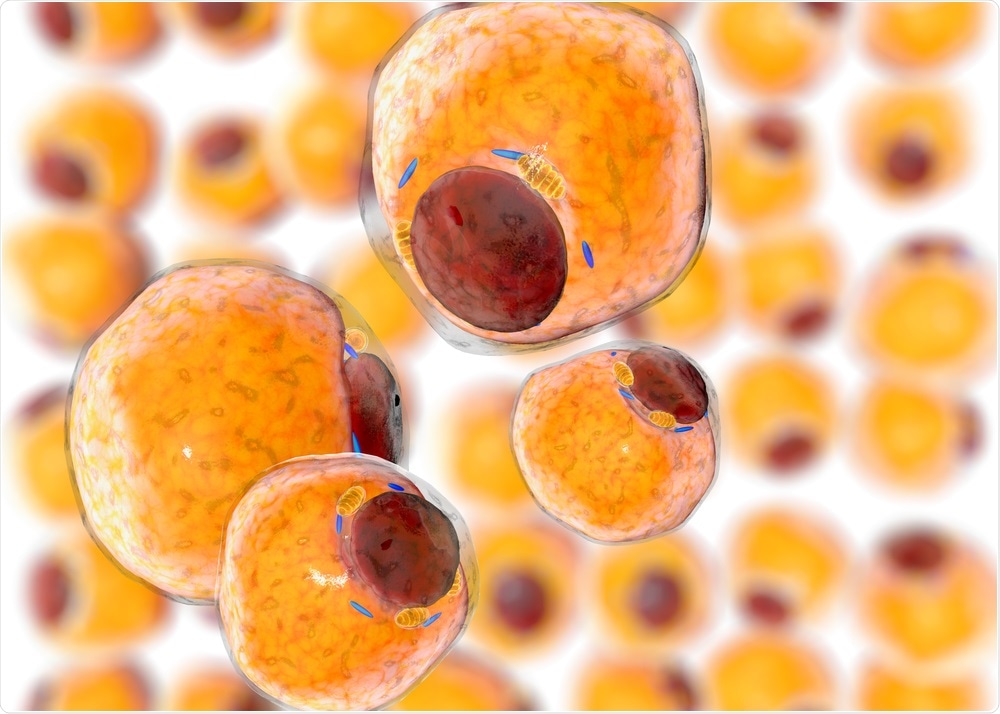Scientists at the Steno Diabetes Center Copenhagen and the University of Copenhagen, Denmark, have established a lipidomic method that proved successful in the analysis of human subcutaneous adipose biopsies.

Image Credit: Pavel Chagochkin/Shutterstock.com
In a paper presented as an unrefereed preprint, the team describes how they applied its new method of profiling of lipids with mass spectrometry to four different body areas to reveal the distinct differences between the adipose composition of those areas.
The innovation will be significant in helping to deepen our understanding of the pathology of conditions such as diabetes, obesity, hypertension, metabolic syndrome, and others.
Analysis of fat storage reveals insights relevant to metabolic diseases
Cells that store lipid (fat) in adipose tissue are known as adipocyte cells, and they are heavily implicated in maintaining homeostasis.
An increase in lipid storage in the adipose tissue along with an alteration to the metabolic function of adipocyte cells is the hallmark of obesity. It is also related to numerous metabolic diseases, such as atherosclerosis, cardiovascular ischemic disease, hypertension, hyperglycemia, and type 2 diabetes.
Therefore, studying adipose tissue at the molecular level is likely to uncover links to these metabolic diseases and highlight those at risk of developing them. This was the motivation behind the Danish team’s research who sought to design a technique for revealing the molecular composition of adipose tissue for this purpose.
The research adds to the growing body of work that is establishing lipidomics in the ‘omics’ field as an increasingly useful approach for understanding biological systems, particularly, for revealing metabolic pathways and growing our knowledge on lipid biology.
In this case, the team used it to demonstrate the lipid composition of different body areas, revealing the fat consumption of the individual over the time frame of a year, an improvement on current blood methods that are limited to a time scale of just weeks or months.
The research
The team used ultra-high-performance liquid chromatography alongside quadrupole time-of-flight mass spectrometry to analyze tissue biopsies taken from the adipose tissues of 10 participants. Tissue samples were collected from the four areas of the abdomen, breast, thigh, and lower back. Methods of optimized lipid extraction, sample amount, and sample dilution factor were developed as part of the creation of the technique. The team visualized the differences in levels of lipids in the tissues with heatmaps.
This analysis revealed 187 lipids in 2mg of the sample. What is more, the variation of the lipid-class specific internal standards was reported as being less than 5%, therefore, signaling the repeatability of the technique.
Overall, the adipose tissue samples were found to highly represent triacylglycerols and lipids from 13 lipid classes. Also, long polyunsaturated triacylglycerols were found in higher levels in the back, demonstrating that this particular lipidome was area-specific.
Lipidomics of adipose tissue could help treat disease
The new technique that the team describes represents a feasible method of analyzing the lipid profiles from 2 mg samples of adipose tissue.
Previous studies have demonstrated the level of fat across the body is a key marker of health, also, this study proposes that also, the distribution of fat across the body is a key indicator of metabolic disorders.
Therefore, the new method is presented as a tool for detecting potentially pathological metabolic aberrations, which could have a significant impact on future developments for preventions and treatments for multiple metabolic diseases.
Also, new studies have linked lipidomic profiling of adipose tissue to cancer, and therefore, the potential future applications of this new technique may be wider than initially assumed. Further research is needed before developing this technique to specifically address these diseases, including cancer, which we should expect to see in the coming years.
Journal references:
Al-Sari, N., Suvitaival, T., Mattila, I., Ali, A., Ahonen, L., Trost, K., Henriksen, T., Pociot, F., Dragsted, L. and Legido-Quigley, C. (2020). Lipidomics of human adipose tissue reveals diversity between body areas. https://www.biorxiv.org/content/10.1101/2020.01.20.912527v1.full#ref-10
de Mello, V., Paananen, J., Lindström, J., Lankinen, M., Shi, L., Kuusisto, J., Pihlajamäki, J., Auriola, S., Lehtonen, M., Rolandsson, O., Bergdahl, I., Nordin, E., Ilanne-Parikka, P., Keinänen-Kiukaanniemi, S., Landberg, R., Eriksson, J., Tuomilehto, J., Hanhineva, K. and Uusitupa, M. (2017). Indolepropionic acid and novel lipid metabolites are associated with a lower risk of type 2 diabetes in the Finnish Diabetes Prevention Study. Scientific Reports, 7(1). https://www.ncbi.nlm.nih.gov/pubmed/28397877?dopt=Abstract
Gadde, K., Martin, C., Berthoud, H. and Heymsfield, S. (2018). Obesity. Journal of the American College of Cardiology, 71(1), pp.69-84. https://www.jacc.org/doi/10.1016/j.jacc.2017.11.011?ijkey=4366b9d4aa441e55b4be5318ac52c2f50e692e66&keytype2=tf_ipsecsha
Sedger, L., Tull, D., McConville, M., De Souza, D., Rupasinghe, T., Williams, S., Dayalan, S., Lanzer, D., Mackie, H., Lam, T. and Boyages, J. (2016). Lipidomic Profiling of Adipose Tissue Reveals an Inflammatory Signature in Cancer-Related and Primary Lymphedema. PLOS ONE, 11(5), p.e0154650. https://journals.plos.org/plosone/article?id=10.1371/journal.pone.0154650